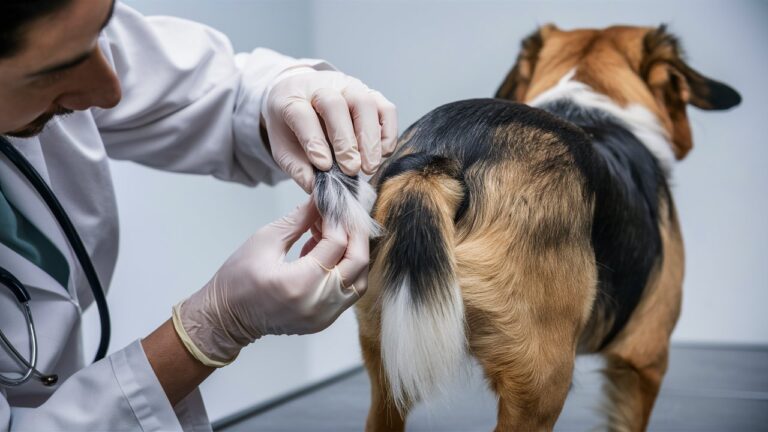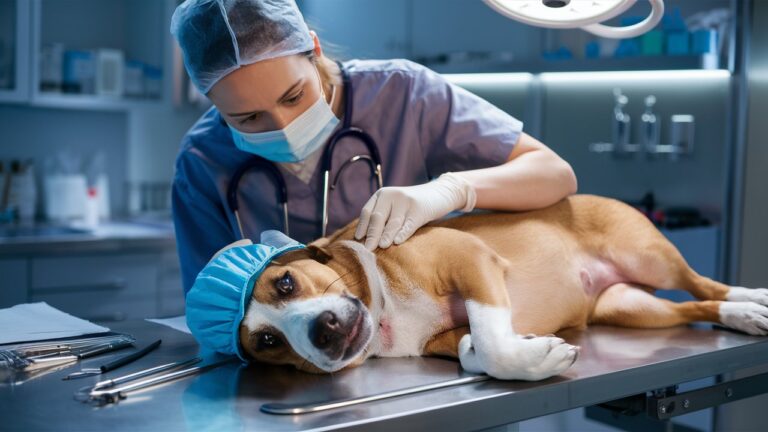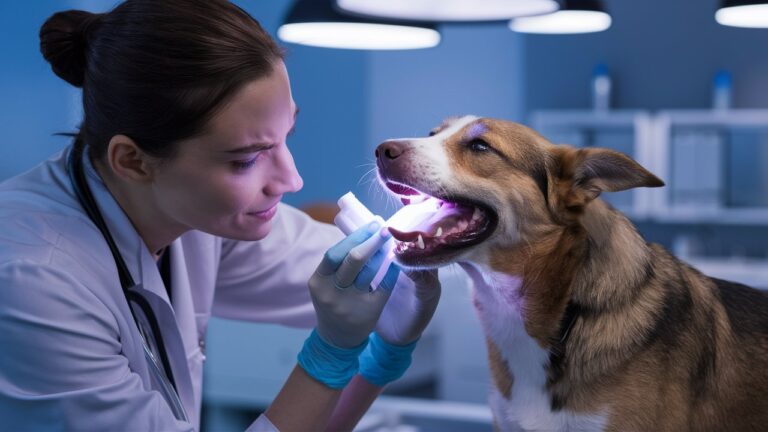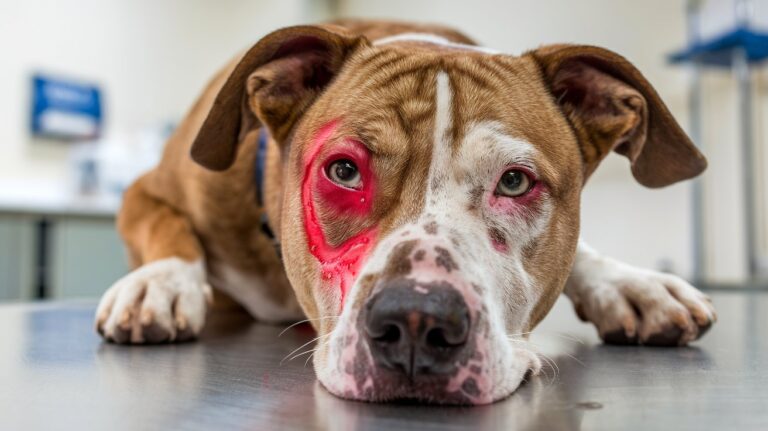Hyperkeratosis in Dogs: 100% Symptoms, Causes, and Effective Treatments
Hyperkeratosis in dogs, often referred to as “hairy dog feet” or “corny feet,” is a condition that affects the skin, particularly the paw pads and nose. This condition leads to the thickening of the outer layer of the skin due to an overproduction of keratin, a protein that helps form the structure of hair, nails, and the outer skin layer. While it might initially seem like a minor issue, hyperkeratosis can significantly impact a dog’s quality of life. This article aims to provide a comprehensive understanding of hyperkeratosis, covering its causes, symptoms, diagnosis, treatment, and management. Additionally, we will include personal anecdotes and stories to make the content more relatable and engaging.
What is Hyperkeratosis in Dogs

Hyperkeratosis is a condition characterized by the excessive growth of keratin, leading to the thickening and hardening of the skin. In dogs, this condition most commonly affects the paw pads and the nose, but it can also appear on other areas of the body. The thickened skin can become cracked and painful, potentially leading to infections and other complications.
Types of Hyperkeratosis in dogs
There are two main types of hyperkeratosis in dogs:
- Nasal Hyperkeratosis: This type affects the nose, causing it to become dry, rough, and crusty. In severe cases, the dog’s nose can crack and bleed, leading to pain and potential infections.
- Paw Pad Hyperkeratosis: This type affects the paw pads, causing them to become thick, hard, and cracked. This can make walking painful for the dog and may lead to secondary infections.
Causes of Hyperkeratosis in Dogs
Hyperkeratosis can be caused by a variety of factors, including genetic predisposition, underlying health conditions, and environmental influences. Some of the most common causes include:
Genetic Factors
Certain breeds are more prone to developing hyperkeratosis due to their genetic makeup. Breeds such as Labrador Retrievers, Golden Retrievers, Irish Setters, and Bedlington Terriers are known to have a higher incidence of the condition. In these cases, the condition is often apparent from a young age.
Underlying Health Conditions
- Infections: Bacterial, fungal, or viral infections can trigger hyperkeratosis. For example, distemper, a viral infection, can lead to nasal and paw pad hyperkeratosis.
- Autoimmune Diseases: Conditions such as pemphigus foliaceus and systemic lupus erythematosus can cause hyperkeratosis as a secondary symptom.
- Metabolic Disorders: Disorders like zinc-responsive dermatosis, which occurs due to a deficiency or improper absorption of zinc, can lead to hyperkeratosis.
Environmental Factors
Prolonged exposure to harsh environmental conditions, such as extreme heat or cold, can contribute to the development of hyperkeratosis. Additionally, exposure to irritants and chemicals, such as those found in certain cleaning products or de-icing salts, can exacerbate the condition.
Symptoms of Hyperkeratosis in Dogs
The symptoms of hyperkeratosis can vary depending on the severity and location of the condition. Common signs to watch for include:
- Thickened Skin: The skin on the nose or paw pads becomes thick and hard.
- Cracked Skin: The affected areas may crack, leading to pain and potential infections.
- Dry, Crusty Nose: In cases of nasal hyperkeratosis, the nose becomes dry, rough, and crusty.
- Lameness or Reluctance to Walk: Paw pad hyperkeratosis can make walking painful, leading to lameness or reluctance to walk.
- Bleeding: Severe cases can result in bleeding from the cracked skin.
Personal Anecdote: Buddy’s Battle with Hyperkeratosis in Dogs
Buddy, a seven-year-old Golden Retriever, had always been an active and playful dog. His owners, John and Lisa, noticed that Buddy’s nose started to look unusually dry and crusty. At first, they thought it might be due to the dry weather, but when Buddy’s nose began to crack and bleed, they knew something was wrong.
A visit to the veterinarian confirmed that Buddy had nasal hyperkeratosis. The vet explained that Buddy’s breed was predisposed to the condition and that they needed to start treatment immediately to prevent further complications. John and Lisa were relieved to have a diagnosis but were concerned about how to manage Buddy’s condition.
Diagnosis of Hyperkeratosis in Dogs
Diagnosing hyperkeratosis in dogs involves a thorough evaluation by a veterinarian, focusing on clinical signs, medical history, and sometimes, diagnostic tests. Prompt diagnosis is crucial for initiating appropriate treatment and preventing further complications associated with the condition. This section explores the diagnostic process for hyperkeratosis, detailing the steps involved and the importance of each in confirming the condition.
Clinical Examination
The initial step in diagnosing hyperkeratosis is a comprehensive clinical examination by a veterinarian. During this examination, the vet will:
- Inspect the Affected Areas: The veterinarian will closely examine the nose and paw pads for signs of thickened, dry, or cracked skin. They will assess the extent of the hyperkeratosis and check for any secondary symptoms such as inflammation or infection.
- Take a Detailed History: Gathering information about the dog’s medical history is essential. The vet will inquire about any previous skin conditions, infections, exposure to environmental irritants, and the duration and progression of current symptoms.
Differential Diagnosis
During the clinical examination, the veterinarian will consider other potential causes of the dog’s symptoms to rule out conditions that may mimic hyperkeratosis, such as:
- Autoimmune Disorders: Conditions like pemphigus foliaceus or discoid lupus erythematosus can cause similar skin changes.
- Infectious Causes: Bacterial, fungal, or viral infections may present with skin thickening and lesions.
- Metabolic Disorders: Disorders affecting zinc metabolism or other nutritional deficiencies can manifest with dermatological symptoms.
Personal Anecdote: Jake’s Diagnosis Journey
Jake, a nine-year-old Labrador Retriever, developed thickened and cracked paw pads over several months. His owner, Mark, noticed Jake licking his paws frequently and showing signs of discomfort while walking. Concerned, Mark took Jake to their veterinarian for an examination.
During the examination, the vet carefully inspected Jake’s paw pads and noted the thickened, dry skin with visible cracks. After discussing Jake’s medical history, which included no prior skin issues or major health concerns, the vet suspected hyperkeratosis. To confirm the diagnosis, the vet recommended further diagnostic tests.
Diagnostic Tests
1. Skin Biopsy
A skin biopsy is often recommended to confirm the diagnosis of hyperkeratosis and rule out other potential causes. During a skin biopsy:
- Tissue Sample: A small sample of tissue is collected from the affected area, usually under local anesthesia.
- Microscopic Examination: The tissue sample is examined under a microscope by a veterinary pathologist. This helps identify changes in the skin structure, including excessive keratinization characteristic of hyperkeratosis.
2. Blood Tests
Blood tests may be conducted to assess the dog’s overall health and screen for underlying conditions that could contribute to or result from hyperkeratosis:
- Complete Blood Count (CBC): This test evaluates the overall health of the dog’s blood cells and can indicate the presence of infection or inflammation.
- Biochemical Profile: A biochemical profile assesses organ function and can detect abnormalities that may be associated with metabolic disorders contributing to hyperkeratosis.
3. Allergy Testing
In cases where allergic reactions are suspected as contributing factors to hyperkeratosis, allergy testing may be recommended:
- Intradermal Skin Testing: This involves injecting small amounts of allergens under the skin to observe for allergic reactions.
- Blood Testing for Allergen-Specific Immunoglobulin E (IgE): Blood tests can measure IgE levels in response to specific allergens, helping to identify potential triggers.
Personal Anecdote: Emma’s Diagnostic Challenge
Emma, a four-year-old Golden Retriever, developed a dry, crusty nose over several weeks. Her owners, Tom and Sarah, were concerned and took her to their veterinarian for an evaluation.
The vet performed a thorough clinical examination and reviewed Emma’s medical history. Given Emma’s breed predisposition to nasal hyperkeratosis, the vet suspected the condition but wanted to confirm the diagnosis with a skin biopsy. The biopsy results showed excessive keratinization of the nasal tissues, confirming nasal hyperkeratosis.
Treatment and Management of Hyperkeratosis
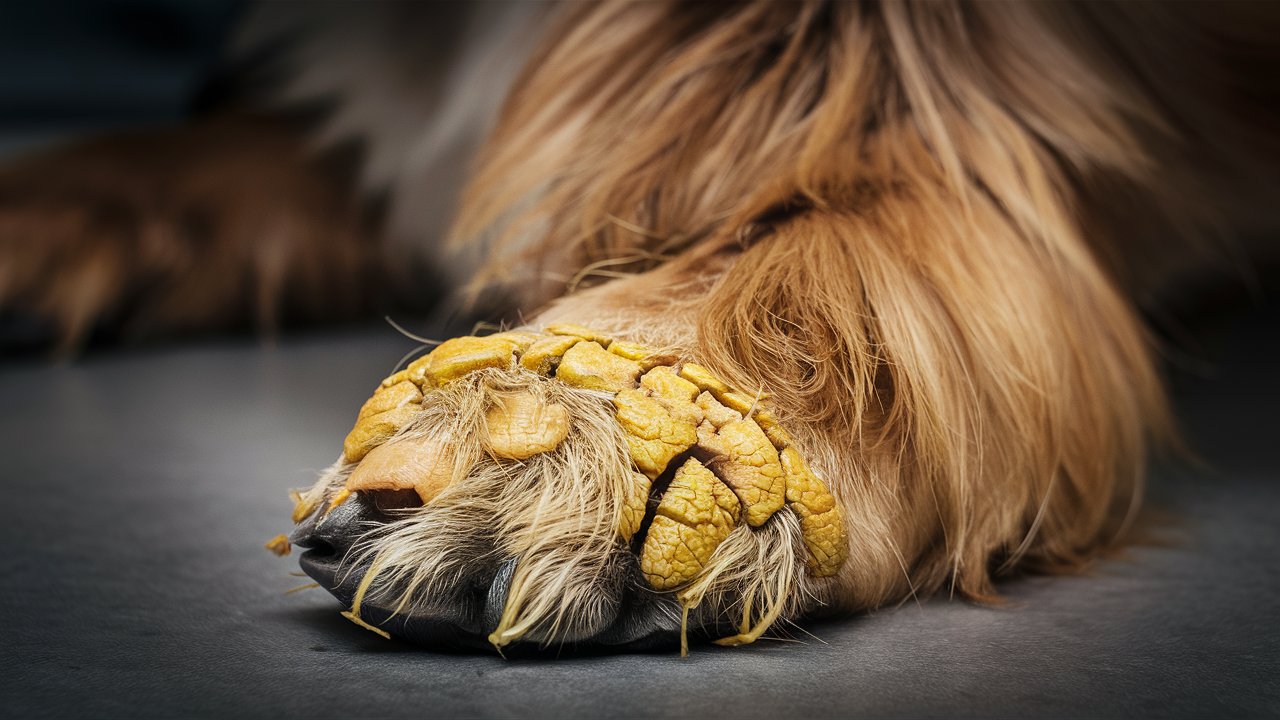
Hyperkeratosis in dogs, characterized by the excessive thickening and hardening of the skin, requires careful treatment and management to alleviate symptoms, prevent complications, and improve the dog’s quality of life. While there is no cure for hyperkeratosis, a combination of topical treatments, medications, dietary supplements, and environmental management can effectively manage the condition.
Topical Treatments
Topical treatments are central to managing hyperkeratosis, focusing on softening and moisturizing the thickened skin to reduce cracking and discomfort.
- Moisturizing Balms and Ointments: Applying moisturizing balms or ointments to the affected areas helps hydrate the skin and soften the thickened keratin. Ingredients such as shea butter, coconut oil, and beeswax are commonly used for their soothing properties.
- Keratolytic Agents: These agents help break down excess keratin, further softening the skin. Common keratolytic agents used in veterinary treatments include salicylic acid and urea. They work by promoting shedding of the outer layers of thickened skin, allowing healthier skin to emerge.
Medications
Medications may be prescribed to manage infections, reduce inflammation, or address underlying health conditions contributing to hyperkeratosis.
- Antibiotics: If the thickened skin becomes infected, antibiotics may be prescribed to treat bacterial or fungal infections. It’s crucial to follow the veterinarian’s instructions for the full course of antibiotics to ensure the infection clears completely.
- Anti-inflammatory Medications: In cases where inflammation accompanies hyperkeratosis, anti-inflammatory medications such as corticosteroids may be prescribed. These medications help reduce swelling, pain, and discomfort associated with the condition.
Dietary Supplements
Dietary supplements can support skin health and may be recommended, especially for dogs with specific nutritional deficiencies related to hyperkeratosis.
- Zinc Supplements: Dogs with zinc-responsive dermatosis may benefit from zinc supplements to correct deficiencies and support healthy skin function. However, it’s essential to consult with a veterinarian before starting any supplements, as excessive zinc intake can also be harmful.
- Omega Fatty Acids: Supplements rich in omega-3 and omega-6 fatty acids can help improve skin barrier function and reduce inflammation, contributing to overall skin health.
Environmental Management
Managing the dog’s environment plays a crucial role in preventing further irritation and damage to the skin affected by hyperkeratosis.
- Protective Measures: Using protective booties can shield the paw pads from abrasive surfaces and prevent exposure to harsh chemicals or environmental irritants like de-icing salts. This helps minimize further damage and discomfort.
- Avoiding Irritants: Avoiding contact with irritants such as harsh cleaning products and pesticides is essential. Choose pet-safe alternatives and ensure any chemicals used in the dog’s environment are non-toxic and gentle on the skin.
Personal Anecdote: Jake’s Journey with Hyperkeratosis
Jake, a nine-year-old Labrador Retriever, developed paw pad hyperkeratosis in dogs that made walking painful and difficult. His owner, Mark, was concerned about Jake’s discomfort and consulted with their veterinarian for guidance.
After a thorough examination, the veterinarian prescribed a treatment plan that included daily application of a moisturizing balm containing shea butter and regular use of protective booties during walks. Jake also received oral antibiotics to treat a secondary bacterial infection in his paw pads.
With consistent care and management, Jake’s paw pads gradually softened, and his mobility improved. Mark diligently followed the veterinarian’s recommendations, ensuring Jake’s environment was free from irritants and providing a balanced diet rich in essential nutrients.
Regular Veterinary Check-ups
Regular veterinary check-ups are essential for monitoring the progress of treatment, adjusting medications as needed, and addressing any new developments or concerns.
- Monitoring Skin Condition: During check-ups, the veterinarian will assess the dog’s skin condition, checking for signs of improvement or worsening of hyperkeratosis. They may recommend additional tests or adjustments to the treatment plan based on their findings.
- Health Monitoring: Veterinary check-ups also allow for monitoring the dog’s overall health, ensuring there are no underlying conditions contributing to hyperkeratosis in dogs that require additional treatment.
Preventing Hyperkeratosis In Dogs
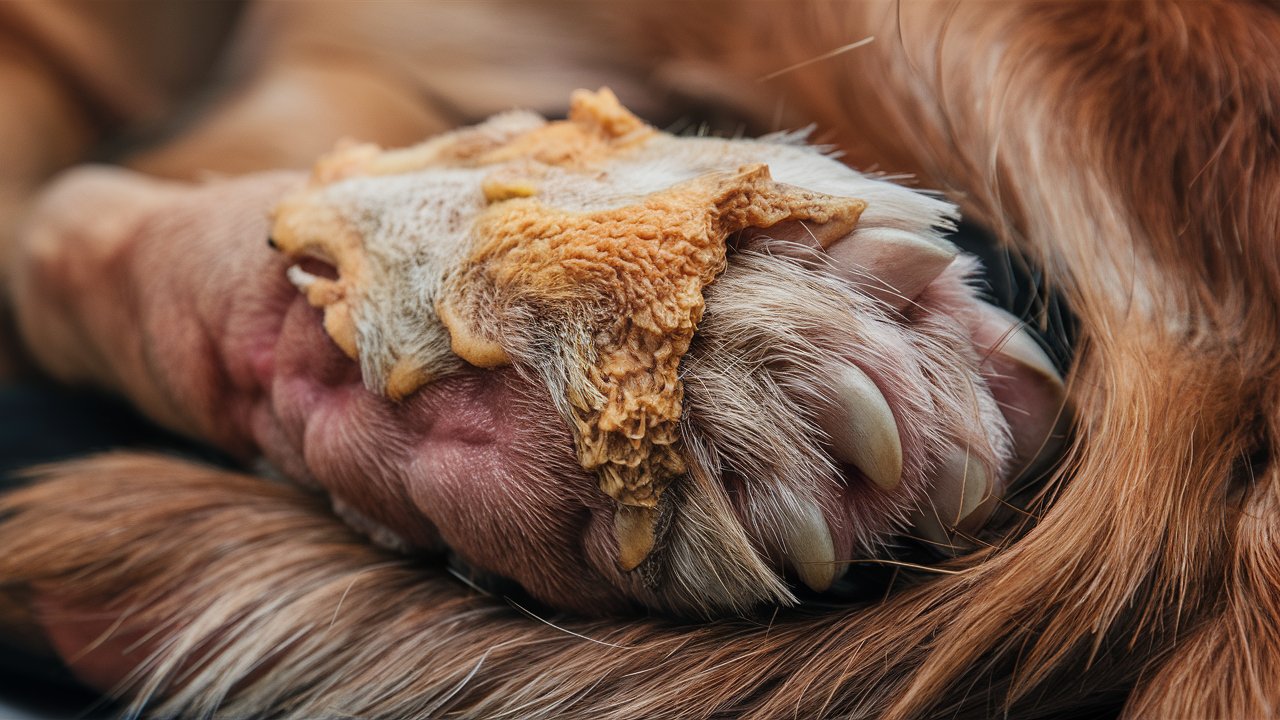
While hyperkeratosis in dogs can be challenging to manage once it develops, there are several proactive measures pet owners can take to reduce the risk of their dogs developing this condition. Prevention focuses on maintaining overall skin health, minimizing exposure to environmental irritants, and ensuring proper nutrition and care.
1. Regular Grooming and Skin Care
Regular grooming is essential for preventing hyperkeratosis in dogs. This includes not only brushing and bathing but also paying attention to the specific needs of your dog’s paw pads and nose.
- Trimming Paw Hair: Keeping the hair around the paw pads trimmed can help reduce the risk of debris and irritants accumulating, which can exacerbate hyperkeratosis.
- Nose Care: Regularly cleaning and moisturizing your dog’s nose can prevent dryness and the subsequent development of nasal hyperkeratosis. Using pet-safe moisturizers can help maintain a healthy, supple nose.
- Paw Pad Care: Regular inspection and moisturizing of the paw pads can help prevent the buildup of keratin. Applying balms designed for paw pads can keep them soft and pliable.
2. Balanced Diet and Nutritional Supplements
Proper nutrition plays a crucial role in maintaining healthy skin and preventing hyperkeratosis. Ensuring your dog has a balanced diet that meets all their nutritional needs can support overall skin health.
- High-Quality Diet: Feed your dog a high-quality, well-balanced diet that includes all essential nutrients. Foods rich in omega-3 and omega-6 fatty acids are particularly beneficial for skin health.
- Zinc Supplements: For breeds prone to zinc-responsive dermatosis, ensuring adequate zinc intake is vital. Consult with your veterinarian to determine if zinc supplements are necessary for your dog.
- Hydration: Adequate water intake is essential for maintaining skin hydration in dogs. Always ensure your dog has access to fresh, clean water.
3. Protective Measures
Taking steps to protect your dog’s paws and nose from harsh environmental conditions can help prevent hyperkeratosis.
- Protective Booties: Using protective booties when walking your dog on rough surfaces, hot pavement, or during cold weather can prevent damage to the paw pads. Booties also protect against chemicals such as de-icing salts.
- Avoiding Irritants: Minimize your dog’s exposure to irritants, including harsh cleaning products, pesticides, and chemicals. When using cleaning agents, ensure they are pet-safe and free of harsh chemicals that could irritate your dog’s skin.
4. Environmental Management
Creating a dog-friendly environment can help reduce the risk of hyperkeratosis in dogs.
- Comfortable Living Area: Ensure your dog has a comfortable and clean living area. Soft bedding can help protect the paw pads from constant pressure and friction.
- Regular Exercise: Regular exercise is essential for overall health, but it’s important to choose appropriate surfaces for your dog to walk on. Avoid overly rough or hot surfaces that could damage the paw pads.
5. Regular Veterinary Check-ups
Regular veterinary check-ups are crucial for early detection and prevention of hyperkeratosis in dogs. Your veterinarian can provide personalized advice based on your dog’s breed, health status, and lifestyle.
- Routine Examinations: Regularly scheduled veterinary examinations can help catch early signs of hyperkeratosis before it becomes a severe problem. Early intervention is key to preventing complications.
- Health Monitoring: Monitor your dog’s overall health, and report any changes in their skin condition to your veterinarian. This includes any signs of dryness, cracking, or unusual thickening of the skin on the nose and paw pads.
Personal Anecdote: Proactive Care for Bella
Bella, a playful two-year-old Irish Setter, had a history of dry and cracked paw pads. Her owner, Jane, was determined to prevent hyperkeratosis and ensure Bella’s comfort. Jane adopted a proactive approach to Bella’s care by incorporating regular grooming, a balanced diet, and protective measures.
Jane trimmed the hair around Bella’s paw pads regularly and applied a moisturizing balm every evening. She also switched Bella’s diet to one rich in omega-3 fatty acids and ensured Bella had access to fresh water at all times. During walks, Bella wore protective booties to shield her paws from rough and hot surfaces.
Jane’s efforts paid off. Bella’s paw pads remained soft and healthy, and she never developed hyperkeratosis in dogs. This proactive care routine not only prevented the condition but also strengthened the bond between Bella and Jane, as Bella enjoyed the extra attention and pampering.
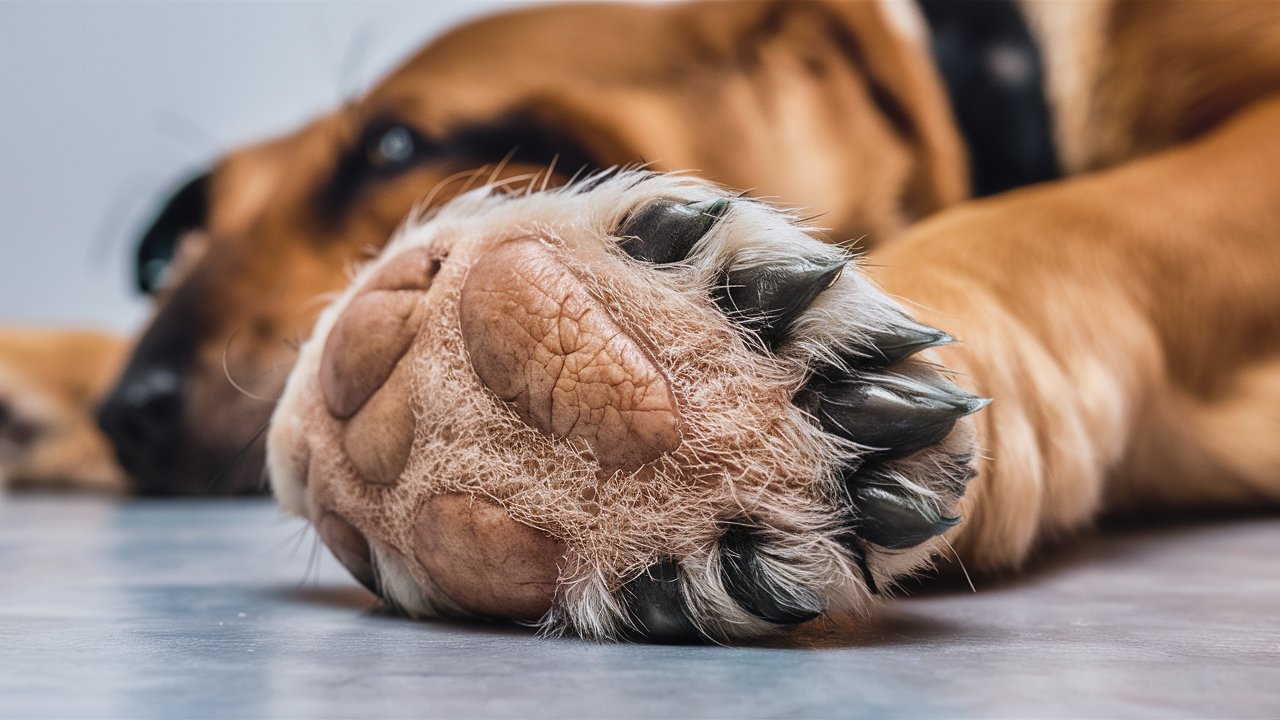
Conclusion
Hyperkeratosis in dogs is a condition that requires careful management and attention. While it can be challenging to deal with, understanding the causes, symptoms, and treatment options can help pet owners provide the best possible care for their furry companions. By working closely with a veterinarian and following a comprehensive treatment plan, hyperkeratosis in dogs can lead comfortable and fulfilling lives.
Personal Anecdote: Final Thoughts on Caring for Dogs with Hyperkeratosis
As a dog owner, it can be heart-wrenching to see your beloved pet in discomfort due to hyperkeratosis in dogs. However, with patience, diligence, and the right support, it is possible to manage the condition effectively. The stories of Buddy, Max, and Daisy highlight the importance of early diagnosis, proper treatment, and regular veterinary care in improving the quality of life for hyperkeratosis in dogs.
By sharing these personal anecdotes and insights, we hope to provide a relatable and engaging perspective on managing hyperkeratosis in dogs. Remember, each dog’s journey is unique, and with the right care and attention, you can help your furry friend live a happy and healthy life despite the challenges of hyperkeratosis in dogs.
